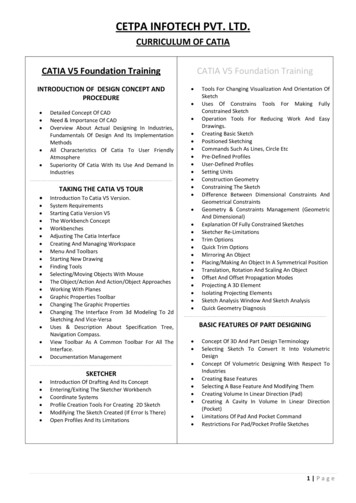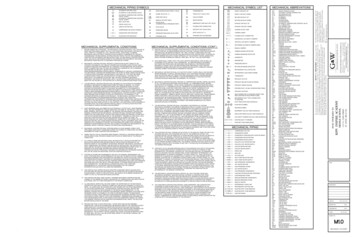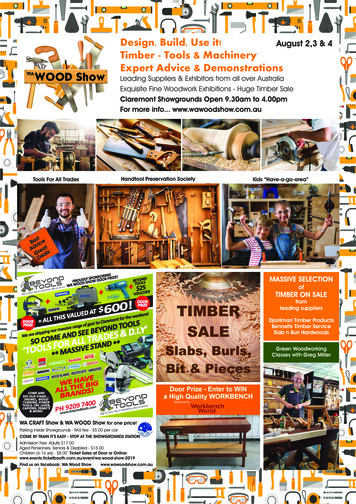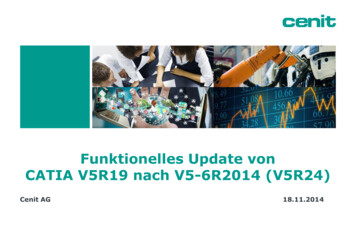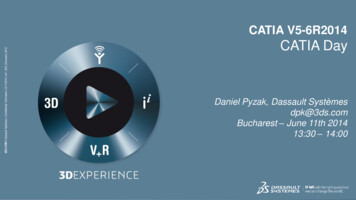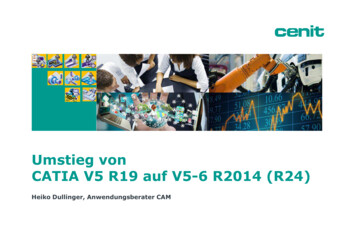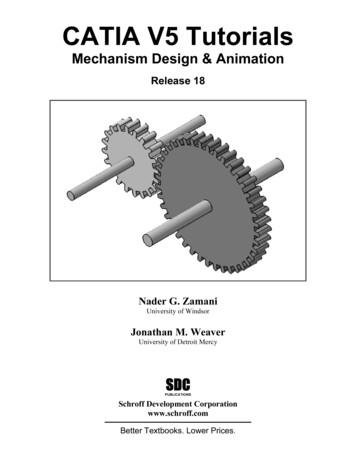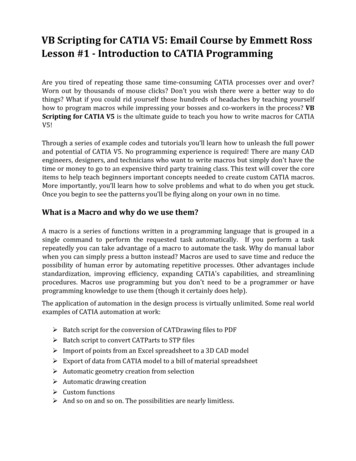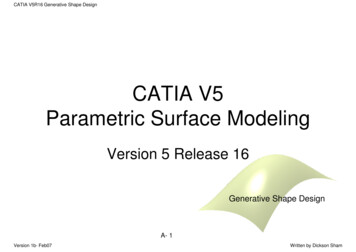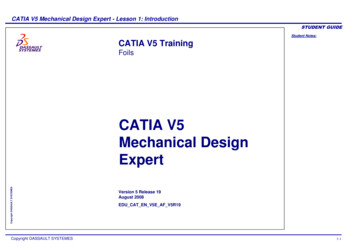
Transcription
CATIA V5 Mechanical Design Expert - Lesson 1: IntroductionCATIA V5 TrainingStudent Notes:FoilsCopyright DASSAULT SYSTEMESCATIA V5Mechanical DesignExpertCopyright DASSAULT SYSTEMESVersion 5 Release 19August 2008EDU CAT EN V5E AF V5R191-1
CATIA V5 Mechanical Design Expert - Lesson 1: IntroductionStudent Notes:IntroductionIntroductionThe goal of the CATIA V5 Expert Mechanical Designer course is to teach you how to start acomplex design project from its specifications (top down approach) and complete it by reusingexisting designs.This course focuses on the advanced skills and concepts that enable you to create robustdesigns.Course Design PhilosophyThis course is designed based on a process or task-based approach to training. Rather than focuson individual features and functions, this course emphasizes the process and procedure tocomplete a particular task. By using case studies to illustrate these processes, you will learn thenecessary commands, options, and menus within the context of completing a design task.Target audienceThe target audience for this course are mechanical designers already having an experience ofCATIA V5 mechanical design foundations.Copyright DASSAULT SYSTEMESPrerequisites5 daysStudents attending this course should meet these criteria:Mechanical design experienceTraining on CATIA V5 FundamentalsCopyright DASSAULT SYSTEMES1-2
CATIA V5 Mechanical Design Expert - Lesson 1: IntroductionStudent Notes:About the Student GuideUsing the Student GuideThis student guide is intended to be used under the guidance of a certified CATIA instructor. Theexamples and case studies are designed to be demonstrated by the instructor.Exercises/Case StudiesThis course illustrates the process-based approach in two ways: exercises and case studies.Exercises give you the opportunity to apply and practice the material covered during the lectureand demonstration. They are designed to represent specific design and modeling situations. Extraexercises have been included in this guide to accommodate students who may want to practicemore modeling. Case studies provide a context in which you use the required tools and methods,and illustrate the process flow you would use for a project.FeedbackCopyright DASSAULT SYSTEMESDassault Systemes gladly accepts feedback and suggestions on its courseware. Send yourfeedback by mail or e-mail: Mail: Dassault SystemesEducation Department22 Quai Galleini, 92150 Suresnes, FranceCopyright DASSAULT SYSTEMES E-Mail: education@ds-fr.com1-3
CATIA V5 Mechanical Design Expert - Lesson 1: IntroductionStudent Notes:Conventions used in the Student GuideThe following typographic conventions are used in thestudent guide:Copyright DASSAULT SYSTEMES Bold blue text within a sentence denotes options selectedfrom the CATIA menu bar. Red brown text denotes the name of a tool, icon, button, orwindow option. Italic text within a sentence is used to emphasize key words. Numerical lists are used in sequential lists, such as the stepsof a procedure. Lower-case alphabetical lists are used in sequential sub-lists,such as the sub-steps in an exercise procedure. 2b identifies areas in a picture that are associated with stepsin a sequential list, such as in an exercise. Upper-case alphabetical lists are used in non-sequential lists,such as a list of options or definitions. Text enclosed in brackets represents the name of thekeyboard key that must be pressed. Text enclosed in [ ] brackets corresponds to the text that mustbe entered into a text field of a CATIA dialog box or prompt.Copyright DASSAULT SYSTEMESExample page:Use the following steps to create a new documentin CATIA:1. Click Start Mechanical Design PartDesign.2. Create new part.a.Click File New.b.Select Part from the New window.c. Select OK.2bd.Press CTRL S to save thedocument.e.Enter [my first document] as thedocument name.You can create the following profile types:A. User Defined ProfilesB. Pre-Defined ProfilesC. CirclesAB1-4
CATIA V5 Mechanical Design Expert - Lesson 1: IntroductionCase StudyStudent Notes:Copyright DASSAULT SYSTEMESEach lesson in this course contains a case study, which explains the skills and conceptscovered in the lesson. The case study will be described at the beginning of each lesson. Thestudent will be able to do the case study exercise once the theory for that lesson has beencovered.These models help to relate the topics discussed in each lesson. It is important to rememberthat the topics discussed in each lesson can be used in many applications, they do not have tobe used together. They are brought together to understand the use of these methods andtools. At the end of this lesson you will work on a warm up exercise that will help you to recallwhat you learnt in the V5 Fundamentals course.Copyright DASSAULT SYSTEMES1-5
CATIA V5 Mechanical Design Expert - Lesson 1: IntroductionDesign IntentStudent Notes:Each case study contains a set of modelrequirements, known as the design intent. Thedesign intent section will help you to understandwhy the tools you are about to learn are needed.The first case study does not contain a designintent because you are not designing anything.However, by the end of this lesson you should beable to:Copyright DASSAULT SYSTEMESRecall the Part Design workbench and thetools you learned in the Introduction course.Recall the importance of parent childrelationships.Understand the importance of organizingbodies.Copyright DASSAULT SYSTEMES1-6
CATIA V5 Mechanical Design Expert - Lesson 1: IntroductionStages in the ProcessStudent Notes:Each lesson explains the material in steps, whichoutline procedures to create the part or an assemblyin the case study. Each step contains theinformation you need to complete the case studyand maintain its design intent. These steps do nothave to be used together. They have been broughttogether for the case study. In each lesson try tothink of other uses for all the steps.For this lesson, you will go through the followingsteps to complete the introductory lesson:Copyright DASSAULT SYSTEMES1. Review the user interface.2. Understand the importance of parent-childrelationships.3. Understand how to organize the model.Copyright DASSAULT SYSTEMES1-7
CATIA V5 Mechanical Design Expert - Lesson 1: IntroductionStudent Notes:Review the User InterfaceIn this section, you will review the user interfaceof the workbenches you have studied in the V5Fundamentals Course. You will also beintroduced to the Generative Shape DesignWorkbench.Use the following steps:1.2.Importance ofParent/ChildRelationshipsOrganizing a Model.Copyright DASSAULT SYSTEMES3.Review the UserInterface.Copyright DASSAULT SYSTEMES1-8
CATIA V5 Mechanical Design Expert - Lesson 1: IntroductionCATIA WorkbenchesStudent Notes:CATIA is a mechanical design software. It is afeature-based, parametric solid modelingdesign tool that takes advantage of the easyto-learn Windows graphical user interface. Youcan create fully associative 3D solid modelswith or without constraints while utilizingautomatic or user-defined relations to capturedesign intent.Copyright DASSAULT SYSTEMESIn the V5 Fundamentals course, you wereintroduced to the Part design, Sketcher,Assembly Design and Drafting workbenches.You have also practiced working with sometools in these workbenches by performing theExercises and Case Studies.In this course, you will learn more about thePart Design and Assembly Designworkbenches. You will also learn somefunctionalities available in the GenerativeShape Design workbench.Copyright DASSAULT SYSTEMES1-9
CATIA V5 Mechanical Design Expert - Lesson 1: IntroductionPart Design WorkbenchStudent Notes:The Part Design workbench lets you buildsolid 3D geometry. It is one of theprimary CATIA workbenches. From thePart Design workbench you can accessthe Sketcher workbench and create 2Dprofiles that will become 3D model.In the V5 Fundamentals course, you havelearned about the sketch-based anddress-up features. In this course you willlearn about additional tools and modelingtechniques such as the multi-bodymethod.Copyright DASSAULT SYSTEMESYou will also learn how to access thisworkbench from the Assembly Designworkbench where you can usecollaborative methods such as Designingin Context and the Skeleton method.Copyright DASSAULT SYSTEMES1-10
CATIA V5 Mechanical Design Expert - Lesson 1: IntroductionAssembly Design WorkbenchStudent Notes:The Assembly Design workbench allowsyou to bring components together tocreate the final product.In the V5 Fundamentals course, youlearned how to rigidly constraincomponents to build assemblies. In thiscourse you will learn how to build flexibleassemblies and analyze assemblies.You will also learn how to access the PartDesign workbench from the AssemblyDesign workbench. This lets you buildparts in the context of the assembly.Contextual design is a powerful tool tocreate parts in an associative manner.Copyright DASSAULT SYSTEMESYou will also learn methods of designingassemblies that will aid in concurrentengineering, such as Skeleton modelsand publishing elements.Copyright DASSAULT SYSTEMES1-11
CATIA V5 Mechanical Design Expert - Lesson 1: IntroductionGenerative Shape Design WorkbenchStudent Notes:In this course you will be introduced toanother workbench, the GenerativeShape Design workbench. Thisworkbench lets you create surface andwireframe geometry.The surface and wireframe geometryallows you to create more complex solidmodels and gives more control over theshape of a model.Copyright DASSAULT SYSTEMESYou will learn about the differentmethods to organize surface-basedmodels and also how to create solidmodels from the surface features.Copyright DASSAULT SYSTEMES1-12
CATIA V5 Mechanical Design Expert - Lesson 1: IntroductionImportance of Parent/Child RelationshipsStudent Notes:In this section, you will recall what parent childrelationships are and why they are important tounderstand when creating a model.Use the following steps:1.2.Importance ofParent/ChildRelationshipsOrganizing a Model.Copyright DASSAULT SYSTEMES3.Review the UserInterface.Copyright DASSAULT SYSTEMES1-13
CATIA V5 Mechanical Design Expert - Lesson 1: IntroductionDesign IntentStudent Notes:Design intent is a plan to construct solid model of a part, in order to convey its visual andfunctional aspects. In order to use a parametric modeler like CATIA efficiently, you mustconsider the design intent before and during the modeling of the part. The techniques usedto create the model affect how the model behaves when it is changed during its life cycle.The way a solid model is built can affect many aspects, including its flexibility to changes, itsstability during the change process, and the resource requirements to compute a new result.Therefore, it is important to take the design intent into account to achieve an efficient solidmodel of the part.The following factors contribute to design intent:Automatic (Implicit) Relations Based on how geometry is sketched, automatic relations provide common geometric relationshipsbetween objects, such as tangency, parallel, perpendicular, horizontal, and vertical.Equations Equations relate dimensions mathematically; they provide an external way to force changes.Copyright DASSAULT SYSTEMESAdditional Relations Other relations added to the model as it is created provide another way to connect related geometry. Somecommon relations are concentric, coincident, and offset.Dimensioning Dimensions of the sketch have an impact on the design intent. Add dimensions in a way that reflects howyou would change them and control the elements.Copyright DASSAULT SYSTEMES1-14
CATIA V5 Mechanical Design Expert - Lesson 1: IntroductionParent/Child Relationships (1/6)Student Notes:The dependency between one feature and the other is known as a parent/child relationship.Changes to the parent feature can affect the child features, so it is important to create theproper relationships when modeling.Parent/child relationships are an important aspect in maintaining the design intent of the model.There are many ways to create a parent/child relationship, some examples are:Selecting a sketch supportCreating the sketcher constraintsProjecting 3D geometry in a sketchSelecting certain depth options (like Up to surface, Up to Plane, etc.)Copyright DASSAULT SYSTEMES Copyright DASSAULT SYSTEMES1-15
CATIA V5 Mechanical Design Expert - Lesson 1: IntroductionParent/Child Relationships (2/6)Student Notes:While modeling in CATIA, it is important to understand that the steps to create the model are asimportant as the end result.You should carefully consider choosing the best base feature, what parent/child relationshipsshould exist, and what dimensions and feature order best reflect the planned design intent.Many design practices are derived from company standards and need to be considered beforemodeling. Some common design practices are:Copyright DASSAULT SYSTEMESAlways choose the most stable feature in the model as the base feature.Try to avoid creating references to dress-up features such as fillets and chamfers. These featuresmay be removed in downstream applications.Choose the best depth option for the application. For example, decide if a pocket is required tocut through the entire model. Creating the pocket with a dimensional depth is not recommended,because the depth of the feature it is cutting through may change; instead, create the pocket withan Up to Last depth.Copyright DASSAULT SYSTEMES1-16
CATIA V5 Mechanical Design Expert - Lesson 1: IntroductionStudent Notes:Parent/Child Relationships (3/6)3D reference elements are used mainly to reduce the impact of deletions and optimizedesigning of parts and their modifications. They are used to ensure consistent parentchildren relationships.First caseA.B.C.BCreate a Base Pad from thesketch shown.Create another sketch on the topface of Base Pad. Constrain thesketch completely using theedges of the Pad. Using thissketch create an
The goal of the CATIA V5 Expert Mechanical Designer course is to teach you how to start a complex design project from its specifications (top down approach) and complete it by reusing existing designs.
